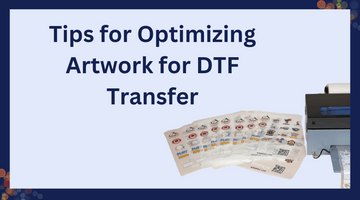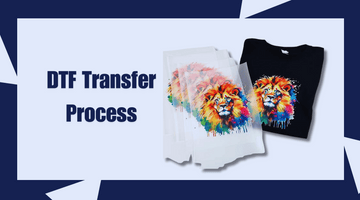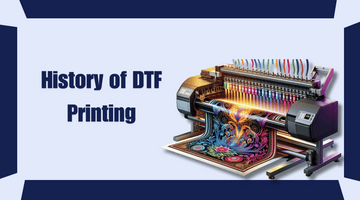
Have you heard about the Picasso of printing? If not, you're in for a treat.
Direct-to-Film printing, or DTF printing, is a state-of-the-art technology that can bring your ideas to life in exceptional quality.
This blog is meant to help you make the best decisions for yourself. Whether you want to print your ideas or are interested in just knowing the what’s and how’s of DTF printing.
What is Direct-to-Film Transfers?
Direct-to-Film Transfers is a method by which one can print designs onto a special PET film. This film has a coating that allows it to transfer the designs onto different items like apparel, canvas, shoes, and much more. Additionally, it's commonly used for making high-quality prints on various items such as clothing, signs, and promotional materials.
However, like any other method, DTF printing has its pros and cons.
What are the Pros of Direct-to-Film Printing?
Easy and Vibrant Prints:
In just two easy stages, DTF printing produces prints that are brilliant and high-quality. Because the ink transfers directly onto the film, producing clear images, it's ideal for complex designs with minute details and seamless color transitions.
Also Read: Introduction to DTF Transfers
Adjustable:
Flexible DTF printing can be used on a wide range of materials, including metals, polymers, and textiles. This procedure works with any type of material—cotton, polyester, light, or dark. Because of its adaptability, it is ideal for companies with a range of printing demands.
Durable:
DTF prints withstand frequent washings and use since they are durable and strong. They meet industry requirements for durability, holding up well after roughly 30 to 50 washes.
Fast and Simple Graphic Setup:
Graphics may be quickly and easily prepared for DTF printing. Due to its support for both RGB (Red, Green, and Blue) and CMYK (Cyan, Magenta, Yellow, and Key) color modes, it is effective for companies that have strict deadlines.
Production at a Low Cost:
When considering other options such as online ordering or on-demand printing, DTF printing offers substantial cost reductions. Businesses can provide competitive prices for their goods when production costs are reduced, which boosts earnings and spurs economic expansion.
User-Friendly:
DTF printing is comparatively simple to learn, which lowers the learning curve for operators. The accessibility of learning this technique can be especially helpful for small enterprises or startups looking for efficient printing without requiring substantial training, even though upkeep is still required.
No Setup Expenses:
DTF printing doesn't need elaborate setups like certain conventional techniques do. It doesn't require any extra money for screen setup and supports an infinite number of colors.
More Production Options:
Using DTF for garment printing eliminates the need for fabric pre-treatment. Furthermore, production isn't restricted to a single location because images are printed onto a transfer. Because of its adaptability, it may be used for both bespoke small-batch printing and large-scale processes.
Also Read: How DTF Transfer Is Different From Other Transfer Methods?
What are the Cons of Direct-to-Film Printing?
Maintenance:
The proper functioning of DTF printing equipment requires routine maintenance. Neglecting maintenance duties might result in issues like worse print quality and longer downtime. In addition, the specific DTF inks require regular cleaning to avoid problems like clogged print heads, which can be expensive to resolve.
Fumes & Ventilation:
When using DTF printing, some inks leak vaporized polymers, which needs to be managed carefully. To maintain a safe working environment, this entails air filtering and occasionally specialized fume extractors or ventilation systems. When printing DTF files, a well-ventilated workplace is crucial.
Equipment Costs and Production:
Although the initial equipment expenditure for DTF printing can be substantial, it can be a cost-effective production process. Businesses must balance these up-front expenses with the savings and long-term advantages.
Why Choose DTF IL for DTF Prints?
With so many advantages, DTF IL is the best place to go for DTF printing. Our prints are of unparalleled quality and longevity, guaranteeing their brightness even after prolonged use. We deliver your items on schedule without sacrificing quality thanks to our quick turnaround times.
Amazing prints are guaranteed every time thanks to the expertise of our staff at DTF IL in managing a wide range of substrates, including glass, leather, and textiles. For companies looking for efficiency, cost, and versatility, DTF printing is still a desirable option despite a few drawbacks. Make DTF IL your first choice when thinking about DTF printing.
FAQs
How long does DTF printing last?
DTF prints typically last through about 30-50 washes, meeting industry standards for durability.
Is DTF better than sublimation?
DTF and sublimation each have their strengths. DTF offers vibrant colors on various fabrics, while sublimation provides seamless integration into polyester fabrics with a soft feel.
What does a DTF transfer feel like on a shirt?
DTF transfers feel smooth on shirts, with the design blending seamlessly into the fabric, offering a comfortable and flexible feel.
How durable are DTF transfers?
DTF transfers are quite durable, withstanding regular use and washing. They hold up well through multiple washes, ensuring long-lasting designs on your garments.




